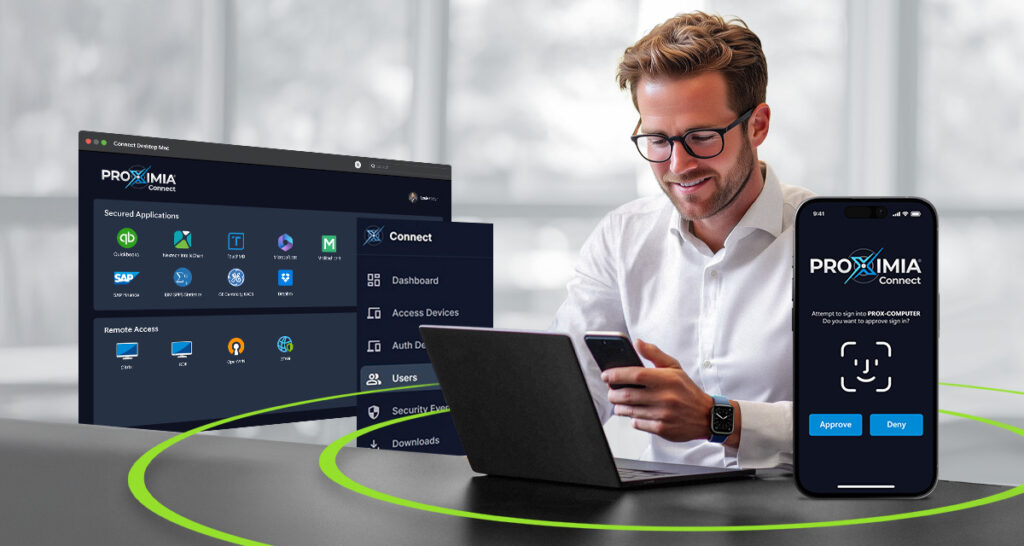In today’s digital-first landscape, the need for robust data security has never been greater. With cyber threats constantly evolving, businesses can no longer rely on traditional security measures, especially when sensitive data is managed by third-party Managed Service Providers (MSPs). While MSPs are tasked with safeguarding your data, not all providers are created equal, especially regarding identity and access management (IAM). This core aspect of security is critical to protecting your sensitive data and preventing unauthorized access.
As the pioneer of passwordless, zero-trust, persistent authentication, Proximia believes that businesses should be asking their MSPs essential questions to ensure their data security standards align with the latest innovations in IAM and cybersecurity.
Understanding Identity and Access Management (IAM)
At its core, IAM is about ensuring that only the right individuals have access to the right resources, at the right time, for the right reasons. However, most businesses today rely on outdated IAM protocols like traditional passwords and basic Multi-Factor Authentication (MFA) for verification. Although familiar, these methods fall short in adequately protecting sensitive data.
Modern IAM must be agile, persistent, and rooted in a zero-trust framework. Here’s why:

Passwordless Authentication
Passwords are often a weak link in data security. Not only are they susceptible to being stolen, but they also place an unnecessary burden on users and IT teams due to resets and management. Passwordless authentication—using biometrics and dynamic factors—is faster and significantly more secure.

Zero Trust
Adopting a zero-trust model means that no device or user is inherently trusted. Instead, each user and device must be verified at every access point. This constant vigilance is crucial to reducing risks associated with lateral movement in the event of a breach.

Persistent Authentication
Static, one-time authentication checks are no longer enough. Persistent verification, a feature at the heart of Proximia, continuously validates a user’s identity throughout their entire session, ensuring that access remains secure as the session progresses.
Is Your MSP’s Authentication Model Enough?
Traditional authentication models—such as static passwords and one-time MFA—are increasingly ineffective against today’s sophisticated cyber threats. Many MSPs rely on familiar, long-standing models and solutions, which can feel secure but often lock clients into outdated paradigms. This can leave data vulnerable to credential-based attacks, phishing, and brute force.
Instead, evaluate whether your MSP supplies and recommends solutions that include the following:
- Zero Trust IAM Principles: Zero Trust is not just a trend; it’s essential. An MSP that upholds Zero Trust principles will continuously validate both user identity and device presence. For example, Proximia’s solution uses biometric triggers and dynamic proximity to ensure that users are authenticated not just once but remain so throughout their session.
- Passwordless Authentication, Done Right: Not all passwordless solutions are created equal. While some rely on a “login once and forget it” model, Proximia takes a layered approach. By utilizing biometric triggers and mutual trust validation, we provide a seamless, secure environment that eliminates reliance on static credentials.
- Persistent Security Monitoring: Many traditional IAM setups leave blind spots after the initial login, which aren’t equipped to handle sophisticated, mid-session attacks. Persistent authentication fills these gaps by continuously verifying user identity, ensuring that sessions remain secure from start to finish.
Assessing Your MSP’s Identity and Access Management (IAM) Technology
 If your MSP isn’t leveraging advanced IAM technologies, it’s time to evaluate their approach to identity and access management. Here are specific areas to discuss:
If your MSP isn’t leveraging advanced IAM technologies, it’s time to evaluate their approach to identity and access management. Here are specific areas to discuss:
- Biometric Triggers and Dynamic Proximity: Does the technology support biometrics in a way that persistently verifies identity during the entire session? Proximia persistently revalidates identity through proximity and mutual trust.
- Device-Agnostic, Multi-Environment Security: Your MSP’s recommended solutions should support secure access across various devices, operating systems, and usage scenarios. Proximia’s compatibility across Windows, shared kiosks, and remote setups meets the needs of today’s hybrid workforce.
- Legacy System Security: Does the IAM solution extend protection to legacy systems that can’t support modern protocols like OAuth or SAML? Proximia extends its secure, passwordless seamlessly to legacy systems.
- Compliance and Regulatory Support: Industries with complex regulatory requirements need IAM solutions that meet compliance standards. Proximia’s compliance-ready features protect data throughout its lifecycle, supporting industry mandates.
In Summary
Before entrusting your data to an MSP, it’s crucial to confirm that their IAM practices are robust, flexible, and capable of adapting to new cybersecurity threats. When an MSP’s chosen technologies lack modern authentication capabilities, they leave your business exposed to risks that could otherwise be mitigated with the right IAM infrastructure. Proximia’s passwordless, zero-trust, and persistent authentication model offers a solution for businesses seeking to take their security to the next level.
To empower your decision-making, we’ve outlined essential questions to ask your MSP about the technologies they use for IAM. This checklist will ensure that your business has the information needed to safeguard its critical assets.
Questions to Ask Your MSP About Identity and Access Management
- How does your authentication model handle continuous verification throughout each session?
- Do you offer passwordless options, and if so, how do they work?
- What security protocols do you use to protect legacy applications?
- Is your IAM framework based on zero-trust principles? How is this implemented?
- How do you manage access control for users across different devices and locations?
- Are there provisions for integrating biometric verification? Is biometric data stored securely?
- How does your approach prevent credential-based attacks, such as credential stuffing or phishing?
- Does your solution include support for compliance standards like GDPR, HIPAA, or others specific to our industry?
- How frequently are credentials updated in your system? Are dynamic credentials available?
- Can your IAM model seamlessly support IoT devices, applications, and various legacy integrations?
- Does your IAM solution include mutual trust verification between users and devices?




